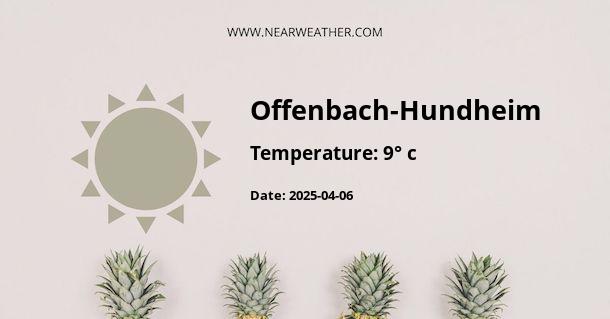Understanding the Climate and Weather Patterns of Offenbach-Hundheim, Germany
Offenbach-Hundheim, a charming locality in Germany, experiences a climate that is characteristic of the central European region. Understanding this area's climate not only supports its residents in planning daily activities, but it is also essential for businesses, travelers, and climate enthusiasts who might be interested in the subtleties of regional weather patterns.
Climatic Overview of Offenbach-Hundheim
Before diving into the monthly specifics, it is essential to understand the general climate of Offenbach-Hundheim. The region experiences a temperate oceanic climate, with moderate to heavy precipitation year-round. The characteristics of the weather are influenced by both the Atlantic Ocean and the continental climate from the east, resulting in a mixture of weather phenomena.
Seasonal Weather Patterns
Spring (March to May)
- Temperatures: Early spring often starts with cool temperatures that gradually increase as summer approaches. Average temperatures range from 3°C to 14°C.
- Precipitation: Rainfall during spring is moderate, averaging between 40 to 55 millimeters per month.
- Climate Events: Late frost events can occur in early spring, while the latter part of the season sees longer daylight hours.
Note: While spring is known for its gradual warming trend, abrupt temperature changes can occur due to cold air incursions from the east.
Summer (June to August)
- Temperatures: Average highs range from 19°C to 24°C, while nighttime lows can drop to around 10°C to 15°C.
- Precipitation: The summer months often bring some of the highest rainfall totals of the year, averaging between 50 to 65 millimeters per month.
- Climate Events: Occasional hot spells and heatwaves can occur, as well as severe thunderstorms due to increased convective activity.
Fall (September to November)
- Temperatures: Temperatures cool down markedly in fall, with averages falling from around 16°C in September to 5°C in November.
- Precipitation: Rainfall during fall remains significant, with averages similar to spring months, although November can sometimes be drier.
- Climate Events: Foggy mornings and frost become more common as the season progresses.
Winter (December to February)
- Temperatures: The coldest month is typically January, with average highs just above freezing and lows around -3°C to -4°C.
- Precipitation: Snowfall occurs, but accumulations are often modest, with liquid-equivalent precipitation ranging from 35 to 45 millimeters per month.
- Climate Events: Cold snaps with sub-freezing temperatures are possible, and grey, overcast skies are commonly observed.
Monthly Weather Detail
| Month | Temperature (°C) | Precipitation (mm) | Sunshine Hours |
|---|---|---|---|
| January | -2 to 3 | 40 | 45 |
| February | -1 to 5 | 35 | 75 |
| March | 1 to 10 | 45 | 120 |
| April | 3 to 14 | 50 | 165 |
| May | 8 to 19 | 55 | 210 |
| June | 12 to 22 | 65 | 240 |
| July | 14 to 24 | 70 | 240 |
| August | 14 to 23 | 60 | 220 |
| September | 10 to 20 | 45 | 180 |
| October | 6 to 14 | 50 | 115 |
| November | 2 to 8 | 45 | 70 |
| December | -1 to 4 | 50 | 45 |
Climate Influences
Several factors influence the weather patterns in Offenbach-Hundheim, including:
- Geographic Location: Its situation in central Europe means exposure to both maritime and continental climate influences.
- Elevation: The area's elevation also plays a role in temperature variations and precipitation.
- Topography: The local topography, such as nearby hills and valleys, can affect microclimates and weather patterns.
- Global Climate Change: As with many regions, local weather patterns in Offenbach-Hundheim can be affected by broader global climate trends.
Extreme Weather and Climate Change Considerations
Offenbach-Hundheim, like many areas, is not immune to the effects of climate change. Extreme weather events, such as heatwaves and severe storms, are expected to increase both in frequency and intensity as global temperatures rise. This has implications for local agriculture, infrastructure, and residents' well-being. Hence, monitoring long-term climate trends is imperative for sustainable planning and adaptation strategies in the region.
Preparedness and Resilience
Building resilience against extreme weather involves understanding local climatic trends, improving infrastructure, and ensuring that community support systems are in place. For instance, heat action plans, improved drainage systems for heavy rainfall events, and winter weather advisories can help mitigate the impacts of climate variability. Local authorities, therefore, play a key role in climate change adaptation and emergency preparedness.
Conclusion
In conclusion, Offenbach-Hundheim offers a prime example of a central European climate that presents both challenges and opportunities for its residents. Whether through the lens of leisure, agriculture, or urban planning, an in-depth understanding of its seasonal weather patterns and the readiness for extreme events relays the importance of climate knowledge in modern society.
It is important to note that the information provided in this article should serve as a general guide. For real-time weather forecasts and alerts, residents and visitors should refer to local meteorological services and stay updated on current conditions. Proactive measures, informed by accurate climate and weather data, will continue to play an essential role in the sustainable development of Offenbach-Hundheim.
A - Offenbach-Hundheim's Latitude is 49.616669 & Longitude is 7.550000.
A - Weather in Offenbach-Hundheim is 2° today.
A - Climate Conditions in Offenbach-Hundheim shows overcast clouds today.
A - Humidity in Offenbach-Hundheim is 90% today.
A - Wind speed in Offenbach-Hundheim is 5.72 km/h, flowing at 207° wind direction. today.
